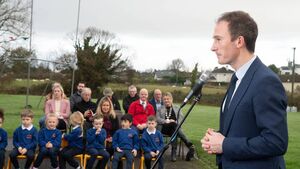Election race in Mayo was never more open

Minister Alan Dillon pictured at Ballyheane National School recently where he turned the sod on the school's new extension. Dillon looks set to top the poll in next Friday's general election. Picture: Alison Laredo
In these pages next week, you’ll be able to read all the election results and pundits like this writer will attempt to analyse the result and draw conclusions. We may attempt to appear sage on the outcome, as if it there was an inevitability about it.
But, right now, a handful of days from the election count, it feels like one of the most unpredictable general elections in Mayo in modern times. Which, for those of us who love the drama of the count centre in the TF, is manna from heaven!
It’s hard to recall a Mayo election with as many candidates with genuine chances (we put that number at ten) and with so few certainties. No Michael Ring for the first time in 30 years, one election after Enda Kenny’s retirement, means it’s an entirely new era in Dáil elections in Mayo.
And it is saying something that the candidate tipped to top the poll, Alan Dillon, only amassed a little over 5,000 first-preference votes the last time, the lowest first-preference of any TD elected in Mayo since the late Séamus Hughes in 1992.
Now a lot of the change has come in Dillon’s continuous improvement as a politician in those five years. He faces this election as a much more comfortable and confident politician than the man who was elected in early 2020.
The absence of Michael Ring has Dillon as the premier Fine Gael candidate in their high-wire four-candidate strategy, and it would not be a surprise if he came close to doubling his vote. But the shadow of his outgoing party colleague will dominate this election.
Every analysis of this election has to assess where Ring’s vote will go. That will be absolutely crucial in determining how this election will play out. He got a staggering 14,796 votes in 2020, all the more impressive when you consider the backlash Fine Gael got nationwide. Where will those votes go?
Well, to start with, you’ve to see where they came from. Midwest Radio political analyst Liam McAndrew, as sharp a mind there is in elections in this county, has crunched a lot of numbers for this election and when you look at how he has broken down Michael Ring’s performance in 2020, what amazes you is the sheer breadth of where he got his vote of just shy of 15,000 from.
Naturally, his biggest vote was in Westport Electoral Area where he picked up 4,449 votes, 49% of the votes cast in that area. Keira Keogh needs to be able to harness a sizeable chunk of that before she gets votes beyond that. Easier said than done. How much of it was a Fine Gael vote versus a personal vote? How much will Ring’s support bring his vote back to her?
Ring picked up 1,859 votes in the Belmullet Electoral Area. How much of this can Keogh get? Will some of it filter back to local TD Rose Conway-Walsh? What of his sizeable share of the vote in Claremorris Electoral Area, 3,376, one in three of every vote cast there. Will Fine Gael’s Martina Jennings harness that? Or will Cllr Patsy O’Brien, now Independent but formerly of Fine Gael, swoop for a good chunk of it? And, on the subject of O’Brien, what impact will the furore about the uncertainty over the reason for his expulsion from Fine Gael impact on the election?
Ring picked up 19% of the vote in Castlebar EA (2,927), a sizeable 1,274 votes as far away as Swinford and only in Ballina did he get less than 1,000 votes (638). Considering he didn’t canvass either of those last two areas, that was some pull all the same. How much of his vote can Keira Keogh expect to get? If she even got half of it, she would be well in the mix.
Who else will benefit from Ring's vote? Alan Dillon? Patsy O’Brien? Martina Jennings? Lisa Chambers? Rose Conway-Walsh?
How Rose Conway-Walsh performs will be fascinating. She picked up a staggering vote of 14,633 first preference votes to be elected on the first count last time. Hardly anyone saw that coming.
In theory, without Ring in the race, she should be strong but the Sinn Féin surge at the time was a big factor and how they will perform nationally this time around is hard to predict.
She picked up 44% of the vote in her home Belmullet Electoral Area in 2020 but that was only 3,269 votes. Without a big urban centre to fall back on, she is a bit more adrift than the other two outgoing TDs running, Dara Calleary in Ballina and Alan Dillon in Castlebar.
She picked up just shy of 4,000 votes in Claremorris and Swinford last time. Now with a running mate in Cllr Gerry Murray, she will not have a call on those votes (though she will hope they will transfer back if Murray is eliminated) and will need to keep up her strong performances in Castlebar (3,093) and Ballina (2,619).
Like Alan Dillon, she has proven herself a capable performer but she cannot be classed as a safe seat.
The TG4 poll last Friday has her in second on 13% behind Dillon on 17%. Dara Calleary (11%), Lisa Chambers and Mark Duffy (both 10%) are next and in the box seats if that plays out though Keira Keogh (8%) and Patsy O’Brien and Paul Lawless (both 7%) are far from out of contention.
Gerry Murray (5%) and Martina Jennings (4%) will be hugely disappointed with their numbers but, like any poll, there has to be a health warning, especially with a sample size of 500 respondents.
The uncertainty is best summed up by Fine Gael, in their first election in the post-Ring and Kenny era. On a really good day, they could take three seats. On a bad day, they might just get one.
Two seems most likely (a tentative nod for Mark Duffy to join Alan Dillon), two for Fianna Fáil is a strong possibility while Rose Conway-Walsh should hold her seat.
But I’ve the humble pie at the ready for next week – if we have a result by then. Dare I say recount? It could be that tight!






